Tillandsia atmospheric: types, rules of care and methods of reproduction
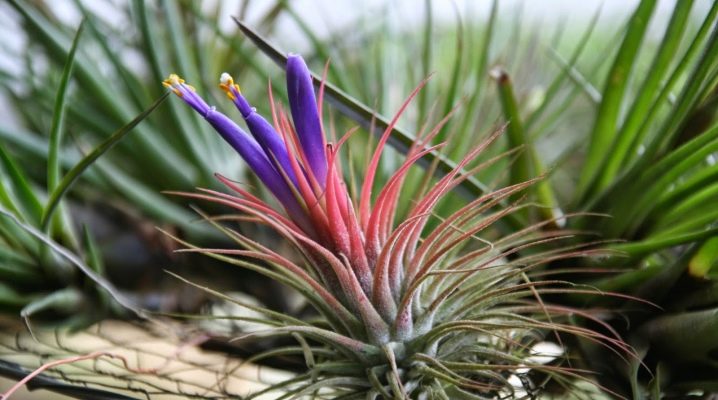
Tillandsia is a herb from the bromeliad family. Currently, about 500 varieties of this unusual plant are known. Of these, I would like to single out a rather interesting species - atmospheric tillandsia. A feature of this indoor pet is the absence of a root system - it receives all the necessary nutrients by spraying through the foliage.
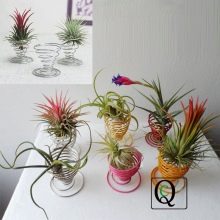
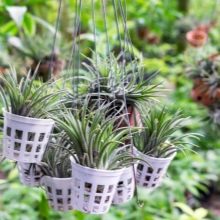

Description
In the natural environment, tillandsia are found on a vast territory: from the United States to the borders of Chile in a wide variety of climatic zones. This flower grows in the humid tropics, and in the arid savannah, and in semi-desert lands, and even in the mountains. That is why the forms of plants differ in many ways, but they are united by one thing - they are all are 100% epiphytes.
Particularly noteworthy are atmospheric tillandsias - they live on snags and trees, clinging to them with small hook-nosed roots, while the nutrients and water necessary for life are obtained directly from the air thanks to special villi on the leaf plates. Typically, atmospheric tillandsias grow on the uppermost branches, hanging down. This variety is distinguished by its love of bright light and coolness.
Today, many varieties of this unusual flower have been successfully adapted for growth and development at home.
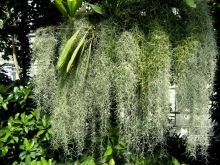
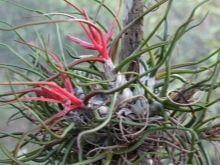
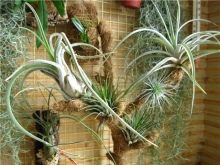
Views
Among the most popular tillandsia varieties allocate the following instances.
- Usneiform. In its natural environment, it lives in the tropical forests of America. It has rather short slender hanging stems, its leaves are shortened, narrowed at the ends, the length varies from 3 to 10 cm, they have a pronounced gray tint. Plants develop successfully without supporting structures, live well in a suspended form and in most cases grow in a cascade from 0.5 to 2 m. Flowers are yellow or blue, flowering usually occurs in the summer.
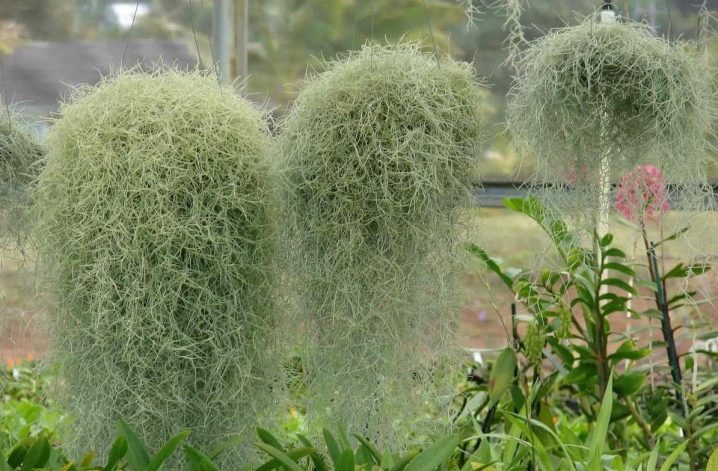
- Violet-flowered. It has rather miniature rosettes 4-5 cm high, leaves are hard, conical. The flowers are blue-violet with oblong petals. Flowering occurs in the summer months, shortly before the buds appear, the inner leaves begin to turn red.

- Silver. This variety is native to Mexico and Cuba. It differs in elongated leaves, the length of which is 6-10 cm, and the width is 1.5-2 cm. The leaves are expanded at the base, grow in a chaotic manner, forming a rather tight rosette. Shortened stems. Summer bloom, buds and flowers are scarlet.
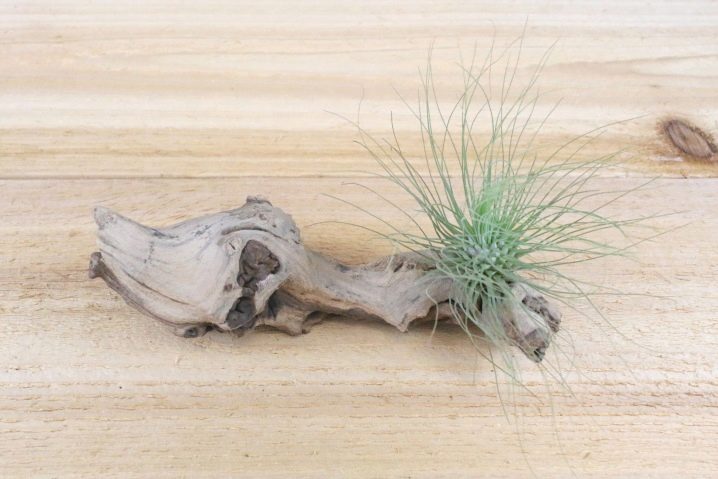
- "Medusa's Head". In its shape, this type of atmospheric epiphyte resembles an ordinary onion, the rosette near the base is quite tightly closed and only as it approaches the top does it begin to open and bend to the sides. Inflorescences are very decorative, deep blue, bracts are red.
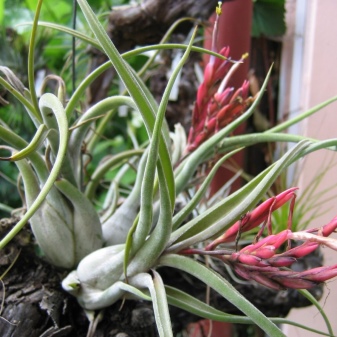
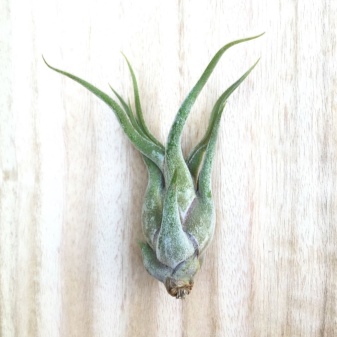
- Tillandsia sticking out. This species is distinguished by narrow (1-1.5 cm) and elongated (up to 20 cm) triangular leaves, the shade is saturated green, the leaf plates are covered with grayish scales. The peduncle is very short, the inflorescences visually resemble a spikelet. It blooms in summer, the shape of the flower is elongated, the shade is light pink.


- Tricolor. This is perhaps one of the most beautiful varieties of tillandsia, it has a very unusual color: the petals are bright green above, yellow in the center, and reddish below. It turns out a "traffic light" on the contrary.The shape of the flower petals is rhomboid. The leaf plates are assembled into a sturdy rosette.
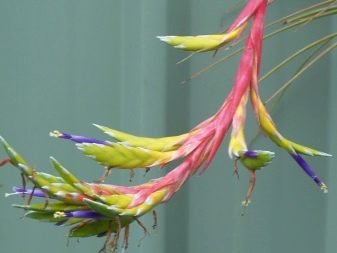
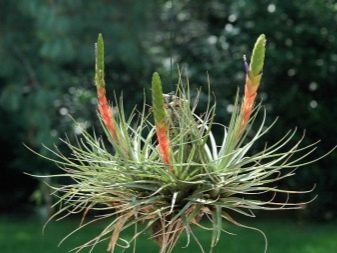
- Duer. Quite an exotic variety, in the flowering phase it visually resembles a rowan leaf. The leaves are narrowed, lingual, collected in a strong rosette. The flowers are very small, white and pink.
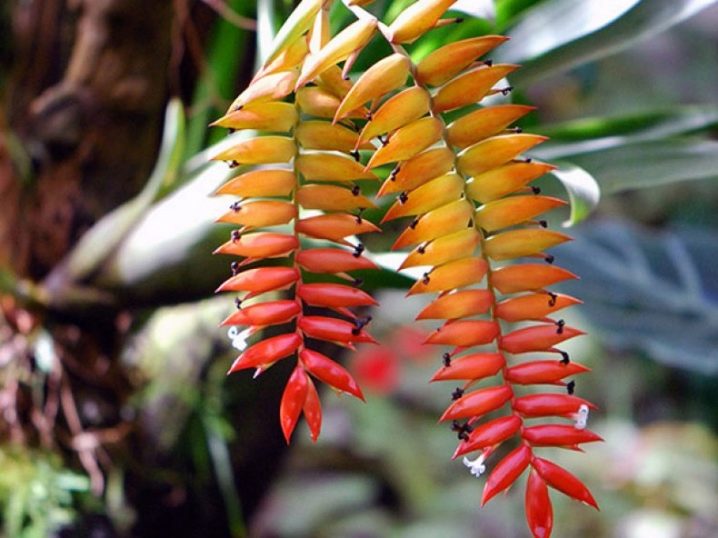
- Anita. This is a selectively bred type of tillandsia. The leaf plates are pointed, rather narrow, covered with small grayish scales, an ear with bracts is distinguished by a lilac or pink color, buds and flowers are of a deep blue hue.
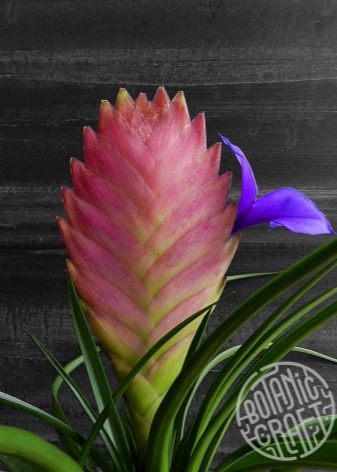
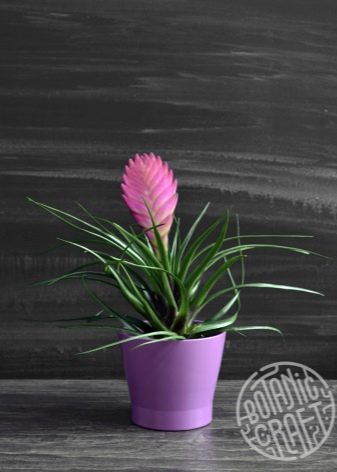
Home care
In order for atmospheric tillandsia to grow and develop successfully, it needs a comfortable living environment. Let us dwell in more detail on individual aspects of caring for this unusual plant.
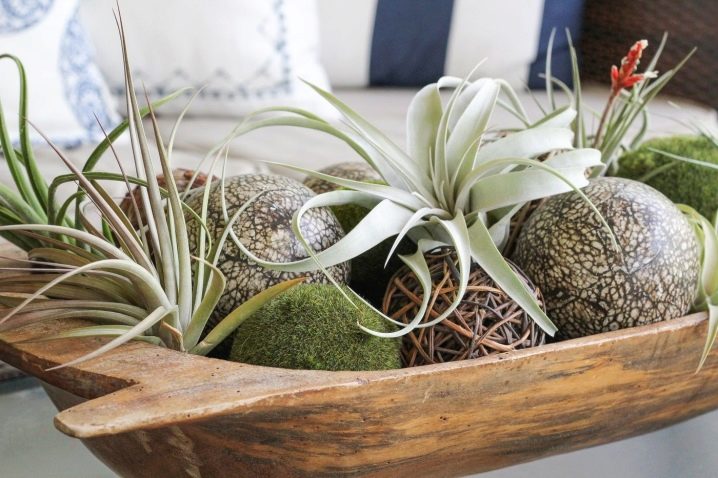
Lighting
Epiphyte must develop on the eastern or western windows... These green pets are quite difficult to grow, in most cases they are grown in florariums, as well as in special decorative bottles. Therefore, when grown from the south side in direct sunlight, the tillandsia may burn and die.
Flowers do not need additional lighting from November to March, they calmly tolerate shading and short daylight hours, moreover, artificial lighting is quite enough for them to function normally, therefore, epiphytes can be grown not only on window sills, but also in the depths of a residential building.

Temperature
As for the temperature background, epiphytes are classified as fairly hardy plants. In their natural environment, they often face short-term temperature fluctuations, and even a decrease in the heat level to 12-13 degrees does not harm them. This property was also transferred to artificially created varieties intended for cultivation at home.
Atmospheric tillandsias require fresh air despite the fact that they are usually referred to as greenhouse crops. Therefore, in the room where they grow, it is necessary to regularly arrange ventilation. At the same time, drafts can destroy the flower; when opening the windows, try to transfer it to a place protected from the wind.
In summer, epiphytes can be placed on a balcony or terrace, protected from direct sunlight, rain and hail. With the onset of cold weather, it is better to bring the tillandsia back into the house.
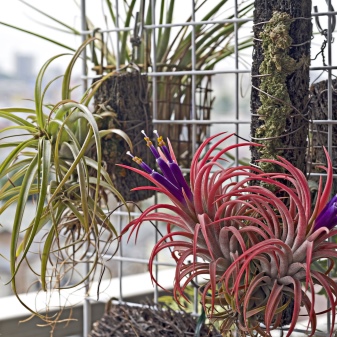
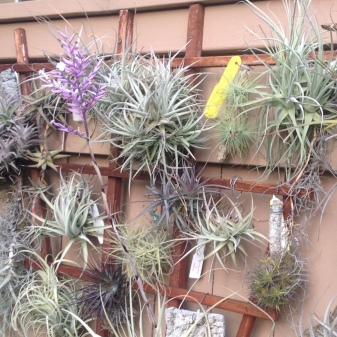
Watering
Separately, it is worth dwelling on the features of watering, the point here is that epiphytes get the moisture they need as a result of spraying. But at the same time it is very important that the liquid accumulated in the substrate does not stagnate, and in the hot months the soil mixture should not be allowed to dry. You can monitor the literacy of irrigation by the appearance of the flower - if it lacks moisture, then the leaves will begin to curl.
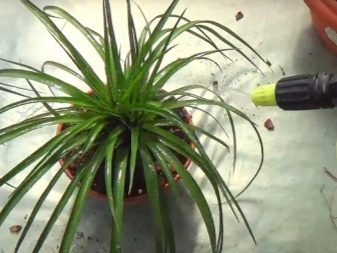

Atmospheric tillandsias require a fairly high humidity - up to 80%, but in a residential environment, maintaining such a parameter is rather problematic and unsafe for residents, therefore, multiple spraying should be combined with the installation of a humidifier. For irrigation you should use only soft water: settled, spring or filtered. Tap water contains a lot of chlorine, which leads to diseases of the leaf plates. The water temperature should be 5-6 degrees warmer than room temperature. In the flowering phase or if the room temperature drops below 15 degrees, spraying should be stopped.
One way to water an atmospheric tillandsia is by placing it in water. To do this, you need to very carefully, without separating the flower from the support, place it in a vessel with water. As soon as the base is completely saturated, the flower must be pulled out, and then the moisture must be completely drained from the leaves.
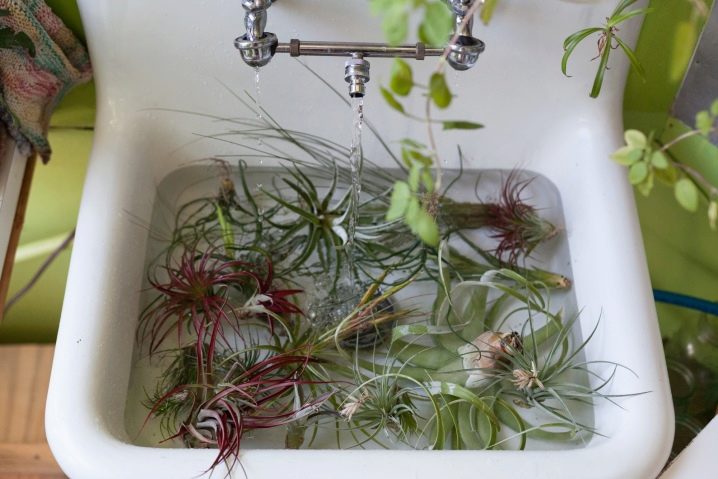
The soil
In the natural environment, these tillandsias live on the decayed bark of trees, therefore, for growing at home, you need to use soil compiled for orchids. If you wish, you can make the soil mixture yourself, for this purpose they combine in equal proportions:
- pieces of bark of coniferous trees;
- clay granulate;
- river stones;
- coconut fiber.
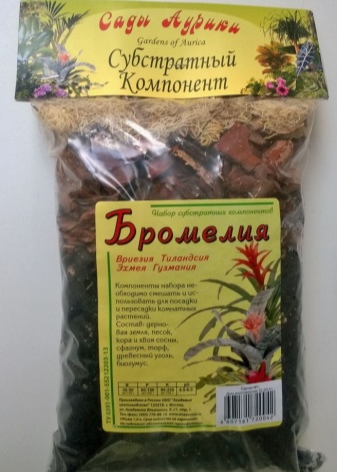
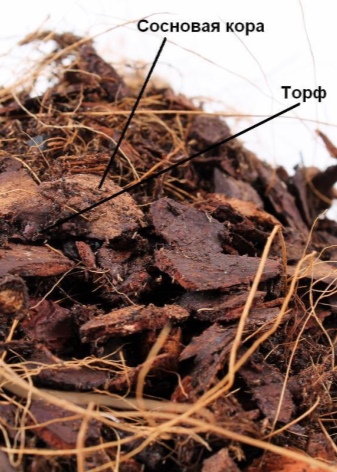
Epiphytes should not be planted in ordinary garden soil, since tillandsia does not take root in it, this flower requires substrate with high air permeability. However, for epiphytes, it is not possible to use the soil at all - it is completely unnecessary to maintain the normal life of the plant.
When creating a decorative composition, you can take any snag, imitation of the ruins of an old castle or interesting stones - they are used as a support and emphasize the tillandsia leaves.
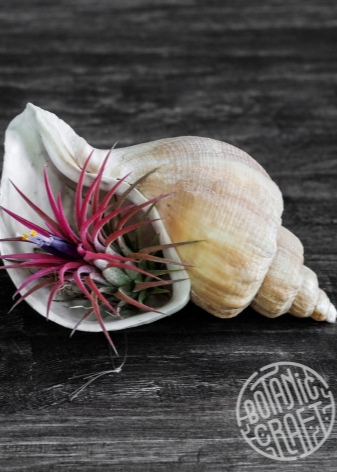
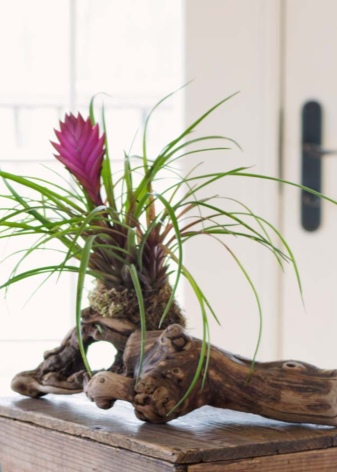
Top dressing
Epiphytes develop very slowly, and in order to speed up this process, light top dressing should be carried out monthly - for this, they buy ready-made preparations for bromeliads, which are bred in accordance with the instructions, and then sprayed with them on leaf plates.
Fertilizer is used only in the spring-summer period at the time of plant activity., in winter, feeding must be stopped, otherwise flower buds will not form. The use of organic fertilizers and urea is strictly not allowed - they contain high concentrations of nitrogen, and it is detrimental to atmospheric tillandsias.

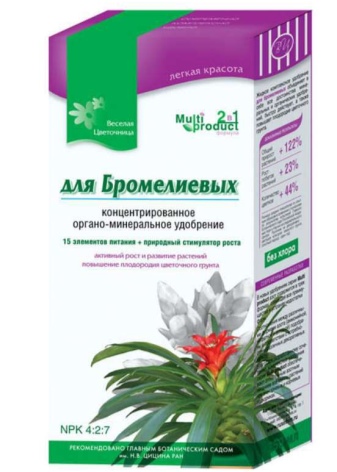
Reproduction methods
Atmospheric tillandsia is propagated vegetatively in two main ways: seeds or babies... The first method is quite laborious and time-consuming, for this the seeds are planted in a special soil, the container is covered with glass and plastic wrap. Keep in mind that tillandsia seeds germinate very quickly, but immediately after that, growth slows down dramatically - from the moment the first shoots appear to flowering, it takes about 10 years.
This method is most often used by breeders to obtain new varieties, in room conditions it is better to give preference to reproduction by children, they appear during the flowering stage. Immediately after the petals have dried, the rosettes must be carefully separated and transferred to a substrate consisting of a mixture of sand and peat. As soon as the roots appear, the plant is transplanted to a permanent place.
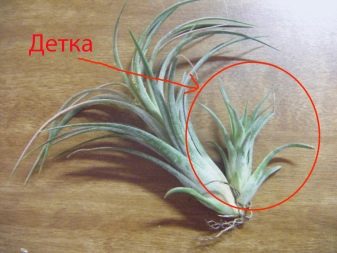
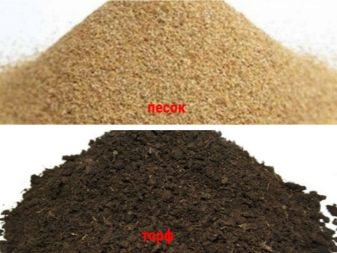
Diseases and pests
Tillandsia has exceptional pest resistance. The only insects that can damage this decorative flower are scale insects, spider mites and mealy worms. If you notice uninvited guests, you should rinse the leaves with a solution of laundry soap as soon as possible, and after a while arrange a warm shower for the epiphyte. If possible, it is necessary to repeat the procedure after a week, and if these measures did not bring the desired disposal of parasites, then it makes sense to resort to special insecticidal preparations. The most effective are "Rogor-S" and "Tanrek".


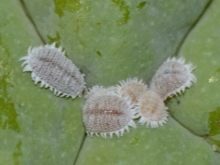
If all the necessary conditions are not followed, the flowers can be susceptible to fungal infections. In this case, it is necessary to remove the damaged areas, and treat the sections of the sections with complex medicinal preparations.
For information on how to care for tillandsia, see the next video.

























The comment was sent successfully.